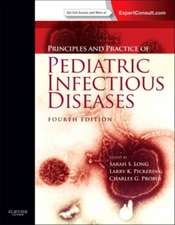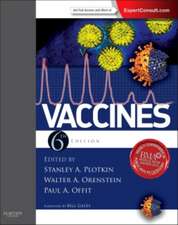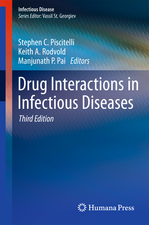Pathogenesis of Wound and Biomaterial-Associated Infections
Editat de Torkel Wadström, Ingvar Eliasson, Ian Holder, Asa Ljunghen Limba Engleză Paperback – 3 sep 1990
Preț: 653.79 lei
Preț vechi: 769.17 lei
-15% Nou
Puncte Express: 981
Preț estimativ în valută:
125.10€ • 130.95$ • 104.13£
125.10€ • 130.95$ • 104.13£
Carte tipărită la comandă
Livrare economică 31 martie-14 aprilie
Preluare comenzi: 021 569.72.76
Specificații
ISBN-13: 9783540195962
ISBN-10: 3540195963
Pagini: 572
Ilustrații: 570 p. 107 illus.
Dimensiuni: 155 x 235 x 30 mm
Greutate: 0.79 kg
Ediția:Softcover reprint of the original 1st ed. 1990
Editura: SPRINGER LONDON
Colecția Springer
Locul publicării:London, United Kingdom
ISBN-10: 3540195963
Pagini: 572
Ilustrații: 570 p. 107 illus.
Dimensiuni: 155 x 235 x 30 mm
Greutate: 0.79 kg
Ediția:Softcover reprint of the original 1st ed. 1990
Editura: SPRINGER LONDON
Colecția Springer
Locul publicării:London, United Kingdom
Public țintă
ResearchCuprins
Healing, Scarring, and Contractures.- The Effect of Staphylococcus aureus Bacteria and its Products on Wound Healing.- Genetic Studies of Staphylococcus aureus Virulence Factors.- Molecular Biology of Group A Streptococcal M Proteins.- Fibronectin Binding Proteins from Staphylococcus aureus.- Fibrinogen-binding proteins from Staphylococcus aureus.- Osteomyelitis and Staphylococcal Adhesion.- Phagocytosis of Bacteria by Endothelial Cells.- Chromosomal DNA Analyses of Staphylococci.- Microbiology of the Burn Compromised Patient.- Immunomodulating Toxins and Tumor Necrosis Factors.- Immunomodulators — Medicine for the 90-ies ?.- Pathogenesis of skin and wound infections. Animal models.- Toxic Shock Syndrome from Surgical Infections.- Fatty Acid Modifying Enzyme (FAME) and Staphylococcal Abscesses.- Biosynthetic Dressing Materials and their Influence on Wound Healing and Infection.- Clinical and Bacteriological Advantages in the Use of Occlusive Dressings.- Development of a Semi-Synthetic Sugar Paste for Promoting Healing of Infected Wounds.- Fibronectin-Substituted Gels for Treatment of Experimental Wound Infections in a Pig Model.- Evaluation of Wound Healing by Quantifying of Bacteria and Computerized Image Analysis — A Pilot Study in Primary Health Care.- Bacterial Affinity for Hydrophobic Ligands can be Employed in the Treatment of Infected Wounds in Patients.- Krill and Other Enzymes in Enzymatic Wound Debridement.- Computerized Wound Image Analysis.- Biomaterial-Centered Infections: Microbial Adhesion versus Tissue Integration.- Periimplant Infections of the Oral Cavity.- Plasmaprotein Adsorption on Solid Surfaces. Some New Methods.- Bacterial Cell-Surface Hydrophobicity.- What Types of Bonds Are Responsible for the Adhesion of Bacteria and Viruses to Native andArtificial Surfaces?.- Pathogenic Studies on Five Species of Coagulase-Negative Staphylococci: A Mouse Model with a Foreign Body Implant.- Experimental Orthopaedic Infections.- Microvascular Graft Infection in the Rat.- Activity of Various Antibiotics on Production of Virulence Factors by Various Organisms.- Structure and DNA-Sequence Analysis of the Staphylococcal Lantibiotics Epidermin and Gallidermin.- Mupirocin: A New Antibiotic that Reduces Colonisation of Central Venous Cannulae by Skin Organisms.- Coagulase-Negative Staphylococci.- Staphylococcus epidermidis — a Versatile Pathogen.- Epidemiological markers of coagulase-negative staphylococci.- Adherence of Staphylococcus aureus to Hep2 Monolayers and Fibronectin.- Deep Infections Associated with Total Hip Arthroplasties Caused by Coagulase-Negative Staphylococci — Pathogenesis and Microbial Diagnosis.- Fibronectin, Collagen and Vitronectin Binding of Coagulase-Negative Staphylococci.- Role of Fibronectin on Staphylococcal Adherence to Metallic Surfaces Used as Models of Orthopaedic Devices.- Serological Variation in the Fibronectin Binding to Protein-A-Deficient Mutants of Staphylococcus aureus.- Adherence of Staphylococci to Monolayers of Human Mesothelial Cells and their Removal by Phagocytes.- Opsonic Requirements of Coagulase-Negative Staphylococci in Suspension and as a Biofilm: Implications for Host Defences.- Microbiology of Infection in Prosthetic Devices.- Prevention of Bacterial Growth Under Commercial Catheter Dressings.- Possible Mechanisms of Damage Which Predispose Heart Valves to Endocarditis.- Phenotypic Variation in the Pathogenesis of Experimental Endocarditis Caused by Staphylococcus epidermidis.- Pathogenesis of Experimental Prosthetic Endocarditis: Effect of Platelet-AssociatedSubstances on Bacterial Survival and Growth.- Fibrinolytic Treatment with Tissue-Type Plasminogen Activator (t-PA) of Streptococcus Sanguis Endocarditis.- Improved Disinfection and Maintenance of Human Heart Valve Allografts.- Hypothetical Model of Phenotypic Variation in Staphylococci.- Phenotypic Changes in Staphylococcal Cell Surface Characteristics Associated with Growth in Human Peritoneal Dialysis Fluid.- Slime Production by Coagulase Negative Staphylococci Causing Single and Recurrent Episodes of Peritonitis.- Etiology and Microbial Pathogenesis of Acute and Late Onset Vascular Graft Infections.- Experimental Bacteremic Vascular Graft Infection with Staphylococcus aureus. Comparative Colonization of Two Graft Materials and Prophylaxis of Late Infection.- Pathogenesis of Infections Caused by Staphylococcus epidermidis.- Gentamicin Release In Vivo from Vacuum Mixed Low and High Viscosity Antibiotic Containing Bone Cement.- The Development of Irgasan-Impregnated Intravenous Cannulae.- The Pathogenesis of Catheter-related Infection in Central Venous Catheters using Gauze versus Transparent Dressings.- In-Vitro Tests to Predict the Efficacy of Antibiotics in a Foreign-Body Infection Animal Model.- Wound Contamination Correlates with Postsurgical Infection Rates: A New Assessment Technique.- Capsular Polysaccharides of Staphylococcus aureus.- The Serodiagnosis of Deep Staphylococcal and Candida Infections.- Concluding Remarks.- Authors’ Index.










